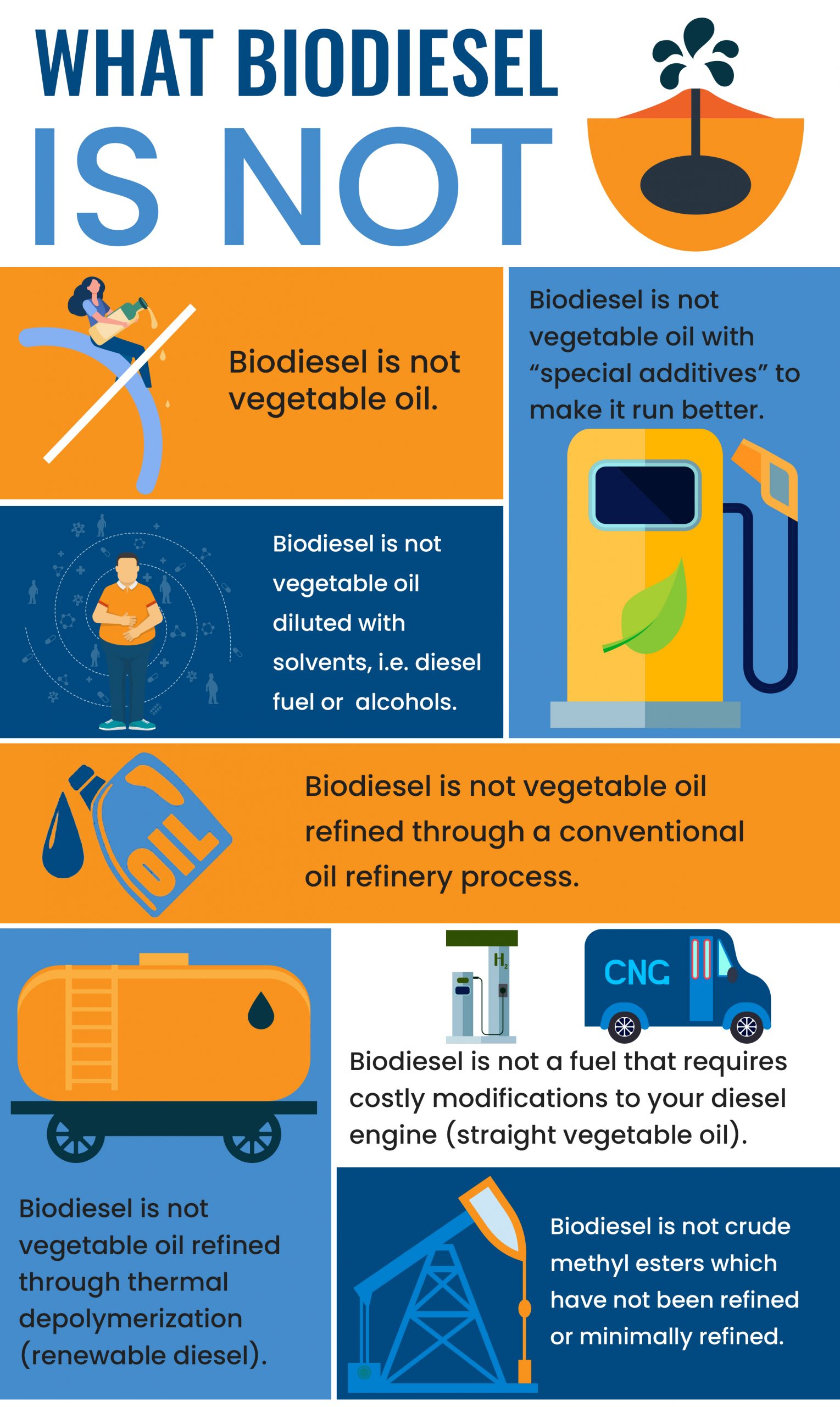WHAT IS BIODIESEL? HOW IS IT MADE, WHO USES IT, AND WHAT IS IT USED FOR?
Whoever said that “change is constant” was right. During the late 1800s, the need to provide an alternative to the inefficient and somewhat dangerous steam engine propelled the invention of diesel engines. This drive to find better fuels for the environment has continued to evolve ever since.
These diesel engines supported the use of several types of fuels. Of course, for some time now petroleum diesel (a type of fossil fuel) remained the gold standard. And why wouldn't it? Petroleum diesel was cheap and readily available. However, negative environmental consequences meant that safer alternatives were always being considered.
Fast forward to the 1970s oil crisis and people began to explore the possibility of other sources of fuel [1]. Long story short, several trials and errors later, biodiesel was born.
What is Biodiesel?
In the simplest of definitions, biodiesel is a clean-burning renewable fuel made from vegetable fats and oils.
It's a bit more complex than this, but this is essentially what biodiesel is.
This biodegradable fuel is not to be confused with vegetable oil
The production of biodiesel is via a chemical process where natural fats and oils are converted into fatty acid methyl esters (FAME). They are excellent for replacing petroleum diesel fuel although both fuels can be blended [2].
Finally, it is not necessary to modify this fuel for use in a diesel engine. That’s because biodiesel already has had modifications made to enable it to be used on diesel engines.
Why?
Before processing into biodiesel, these natural, vegetable-based oils were highly viscous and were not able to power diesel engines. There was a need for a way to lower this viscosity to a suitable level that would support use in diesel engines. Eventually, the transesterification of vegetable oils into fatty acid alkyl esters proved to be a success.
Several other “compounds” have been touted as biodiesel. From those that require modification to suit a diesel engine before they can be used, to those which are said to have been refined or diluted vegetable oil.
The one thing they have in common is that they are always some sort of vegetable oil with some level of treatment. It’s therefore not surprising that most people think vegetable oil is synonymous with biodiesel fuel. However, they’re not the same thing.

Who Uses It?
Just about every industry can find a use for biodiesel. The most common is the use of this fuel in diesel engines. The automobile and trucking industries have naturally found the most widespread use for it.
Biodiesel can also be used to run agriculture machinery. Generators, heating, and lighting equipment can be powered with biodiesel, while biodiesel fuels are also approved for use in marine vessels, especially since they are miscible with marine distillate fuels [3].
The Distinct Uses of Biodiesel
Transportation
In the United States alone, about 28% (2019 data) of total energy consumption was for transportation purposes [4]. Gasoline or petroleum fuels formed the bulk of the fuel for this purpose. However, they are not particularly environment-friendly.
Alternatives such as solar energy are not exactly practical for mass use in transportation.
That's where biodiesel fuel comes in. Already in use in this industry, it's an excellent source of fuel for automobiles and even trains and water vessels. Its also fantastic for the environment because unlike fossil fuels, it does not release CO2 into the atmosphere. Biodiesel reduces black smoke, carbon monoxide, and emissions of other harmful hydrocarbons.
The same goes for biodiesels used in watercrafts. Biodiesel can replace the toxic gasoline that often causes water pollution since its biodegradable and spills from it is not hazardous.
Generation of Energy
Biodiesel can be used to generate power. This has potentially huge benefits for the electricity sector. Biodiesel also does this without the risk of harmful emissions which is perfect for places like schools, hospitals, and even residential areas.
Heat Generation
Regarded as “Bioheat”, biodiesel can be used in home heating systems to generate heat. It can either be used as an additive or as a replacement fuel in furnaces and boilers. Again, this is non-toxic and renewable, making it perfect for green heating needs.
For cooking
Remember when we stated explicitly that biodiesel isn't vegetable oil? We meant that. Biodiesel can be used for cooking as a source of heat for stoves and other fires in the kitchen, but it can’t be used in food.
Extra benefits
Biodiesel can be used for a host of other purposes including charging of electronics, as a great lubricant in engines, and even to remove paint and adhesives [5].
Also, let's not forget that planetary fossil fuel reserves are running low. Combined with the massive rise in global energy demand, biodiesel can come to the rescue. Even with fossil fuels still available, the cost of importation alone takes it's toll on economies. Replacing this with biodiesel might be an excellent way to stabilize some country's economies.

Biodiesel Is On The Rise
One particularly devastating hit to the petroleum industry was the shut down of the Marathon Martinez Refinery in the San Francisco bay area. While this may be another consequence of the unfortunate COVID-19 pandemic, it seems to have had permanent results on the plant.
Described as being “indefinitely idle,” this has hit not just the economy but also the workforce. Over 700 employees lost their jobs. The good news is that there are plans to turn this refinery into a biodiesel plant. [6].
This situation is tragic, however, there is still great hope for the future of biodiesel given all of its uses and how much better it is for the environment than traditional fuel sources.
How It's Made
Biodiesel can be made from several sources including soybean oil, palm oil, canola oil, and other vegetable oils, as well as animal fats. Other than these sources, used cooking oil (yellow grease) and other recycled feedstock forms a huge percentage of sources for biodiesel production [7].
The process of producing biodiesel from these products is known as transesterification. This is the conversion of triglycerides in these oils into biodiesel by methanol (or another short-chain alcohol).
A typical reaction that would produce 100 pounds of biodiesel requires 100 pounds of oil or fat and 10 pounds of alcohol [8].
It begins with the conversion of triglycerides into diglycerides and eventually monoglycerides with the production of one molecule of methyl ester at each step. The process forms FAME (that is, the biodiesel) and glycerin as a by-product.
It is pertinent that these products are made with top-notch standards and following the right specifications such as the ASTM D6751 for pure biodiesel (B100). It should also meet EPA requirements [9].
Biodiesel must be made up of mono-alkyl esters of long-chain fatty acids. This could also be the product of a biodiesel blend.
Essentially, biodiesel can be blended into different concentrations. For instance, there’s B5 (up to 5% biodiesel) and B20 (6 -20% biodiesel). These blends are approved by the American Society for Testing and Materials, (ASTM) for use in compression-ignition engines including light-duty and heavy-duty diesel automobiles and even generators.
Biodiesel blends must meet the ASTM D7467 specifications to be regarded as standard and ensure they have all the required properties [10].
Steps in the Production of Biodiesel
The process is rather ingenious.
Below are the basic steps to make biodiesel, assuming the feedstock is old cooking oil:
- The oil is gathered in a receptacle and transported to the factory. This oil contains water and particles of food, so it must be filtered thoroughly.
- It is then pumped into a holding tank and heated up to draw out the water.
- Next is a multi-stage filtering process with fine meshes on vibrating sieves which removes all particles of food, as well as other particles. The final filtering stage is often through several ultra-fine filters that can trap particles larger than 1 micron.
- The feedstock is combined with methanol and a catalyst in a processing unit. This produces biodiesel and the byproduct - glycerin.
- Purification and desulphurization steps are carried out. Desulphurization refers to a step that removes sulfites in biodiesel [11].
- Numerous tests are carried out as a form of quality control.
Transesterification is quite a complex process. Numerous parameters must be considered before successful production can be attained including reaction time, catalyst type, solvents, feedstock, alcohol, oil molar ratio, and cost of production [12].
A particularly important aspect is the subject of catalysts in the production of biodiesel.

Catalysts and Recycling
The transesterification process requires a catalyst to take place, often in the form of an external catalytic system.
A great catalyst would be one that is not only efficient but also selective, flexible, and consumes less energy. They can either be chemical (homogeneous or heterogeneous agents) or biological, like potassium hydroxide (KOH) and sodium hydroxide (NaOH), for instance.
Some catalysts produce precipitants that can be recycled. This is necessary so the catalyst can be used for other reactions, thereby saving costs. This requires the use of a catalyst which can be continuously withdrawn from the reactors. Once withdrawn, they are regenerated and recycled. This gives it the flexibility needed to work on a wide range of feedstock while enabling it to be used multiple times.
Companies that recycle these catalysts are very important in the production of biodiesels. Recognized Trading & Shipping facilitates the recycling of spent catalysts by shipping them to qualified recycling centers.
Biodiesel production requires several other companies. From the holding company to the filtering plant and of course, the refinery.
Biodiesel Transportation
Unlike fossil fuels that are transported mostly via pipelines, biodiesel is somewhat easier to transport by other means. As mentioned above, biodiesel is produced over a large area, therefore, significant transportation is required.
Trucks and domestic trains can be used as an alternative or supplement to one another, depending on the origin and destination. For instance, the trucks could begin the transportation and it will end in them being delivered by train, or however they deem fit.
Ultimately, being great for our engines, emitting lower greenhouse gas emissions that make it safer for the environment, having potentially high economic opportunities, and more, are all the reasons why biodiesel is gaining so much traction. It's an excellent substitute for fossil fuels, providing us with a highly renewable source of fuel.
When it comes to biodiesel, the future is bright.
References
- HISTORY OF BIODIESEL FUEL. Biodiesel.com. https:// www.biodiesel.com/ history-of- biodiesel-fuel/. Accessed 17-10-2020.
- WHAT IS BIODIESEL? Biodiesel.com. https://www.biodiesel.com/ what-is-biodiesel/. Accessed 17-10-2020.
- Understanding the Opportunities of Biofuels for Marine Shipping. ORNL. https:// info.ornl.gov/sites/ publications/Files/ Pub120597.pdf. Accessed 17-10-2020.
- Use of energy explained - Energy use for transportation. EIA.gov. https://www.eia.gov/ energy explained/use-of-energy/ transportation.php. Accessed 17-10-2020.
- Top 10 Uses for Biofuel. SG Biofuels. https:// www.sgbiofuels.com/ top-10-uses- for -biofuel/. Accessed 17-10-2020.
- Congressman Mark DeSaulnier responds to Marathon Martinez Refinery 'indefinitely idled': 'Big loss'. ABC 7 News. https:// abc7news.com/ marathon- martinez-refinery- congressman- mark-desaulnier -closing-petroleum-co/ 6347455/. Accessed 17-10-2020.
- Everything You Ever Wanted to Know About Biodiesel. Jeremy Martin. UCS USA. https:// blog.ucsusa.org/ jeremy-martin/ all-about-biodiesel. Accessed 17-10-2020.
- Biodiesel Production and Distribution. AFDC. https:// afdc.energy.gov/ fuels/ biodiesel_production .html. Accessed 17-10-2020.
- Top 10 Reasons Smart Customers Are Using Biodiesel. Biodiesel.org. https:// www.biodiesel.org/ docs/default-source/ fact-sheets/ top-10-reasons-to -use- biodiesel.pdf?sfvrsn= 5d027210_18. Accessed 17-10-2020.
- Biodiesel Blends. AFDC. https:// afdc.energy.gov/ fuels/ biodiesel_blends.html. Accessed 17-10-2020.
- Desulfurization. Science Direct. https://www.sciencedirect.com /topics/ engineering /desulfurization. Accessed 17-10-2020.
Catalysts used in biodiesel production: a review. Ali Bohlouli and Leila Mahdavian. https:// www.researchgate.net/ publication/ 331018587 Catalysts used in biodiesel. Accessed 17-10-2020.



